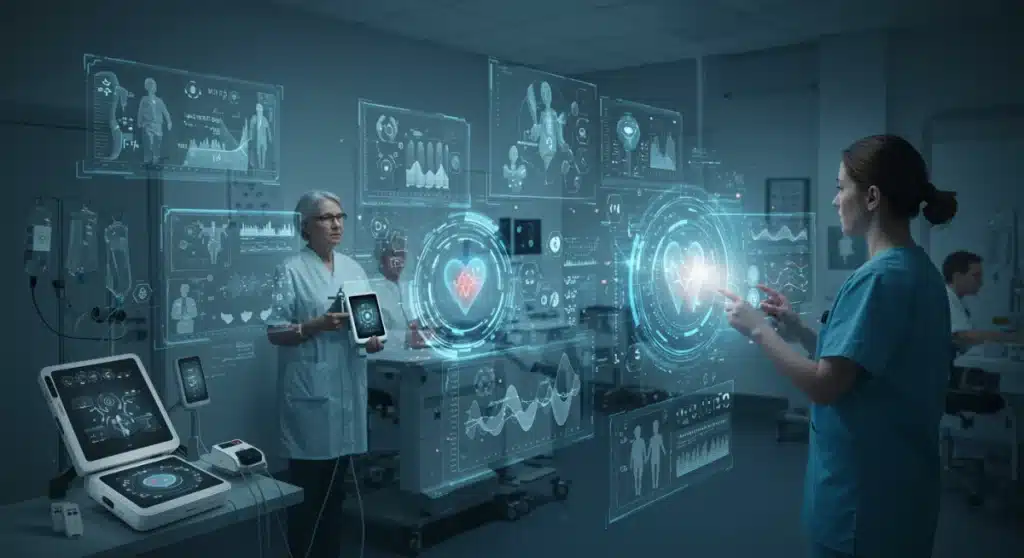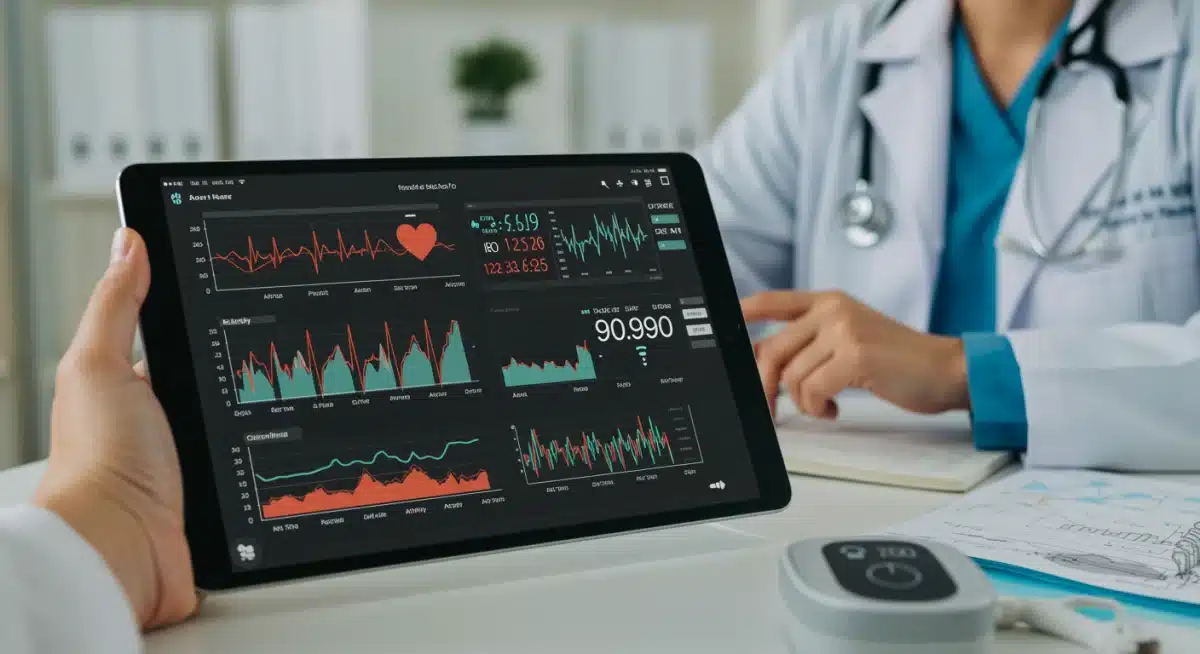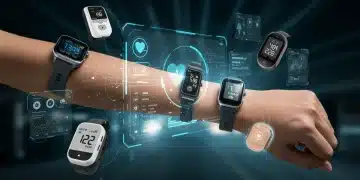IoT Innovations: Reshaping Patient Monitoring in Next 12 Months

Latest developments on IoT patient monitoring innovations are reshaping healthcare, with key advancements poised to transform how patient data is collected and analyzed across the United States in the next 12 months.
IoT patient monitoring is rapidly advancing, fundamentally changing how healthcare is delivered and experienced. In the next 12 months, three major innovations are set to revolutionize connected health, offering unprecedented opportunities for personalized care, early detection, and improved patient outcomes. These developments underscore a critical shift towards proactive and preventive healthcare models.
The Rise of Hyper-Personalized Wearable Sensors
The landscape of patient monitoring is undergoing a significant transformation with the advent of hyper-personalized wearable sensors. These devices are moving beyond basic vital sign tracking to offer granular, context-aware data that reflects an individual’s unique physiological responses and lifestyle. This evolution is driven by advancements in material science, miniaturization, and AI-driven analytics, promising a new era of highly individualized health insights.
These next-generation wearables are designed to integrate seamlessly into daily life, providing continuous, non-invasive monitoring. They collect a vast array of data points, from subtle changes in heart rhythm and blood glucose levels to sleep patterns and stress indicators. The real power lies in their ability to learn from individual baselines and detect deviations that might signal an emerging health issue long before symptoms become apparent.
Advanced Biometric Tracking and Predictive Analytics
- Continuous Glucose Monitoring (CGM) Integration: New wearables are incorporating non-invasive or minimally-invasive CGM technologies, moving beyond traditional finger-prick methods. This provides real-time, continuous glucose data, crucial for diabetes management and prevention.
- Multi-parameter Vital Sign Sensors: Devices are now capable of simultaneously tracking heart rate, blood pressure, oxygen saturation, and body temperature with greater accuracy and in more diverse environments. This holistic view provides a comprehensive physiological snapshot.
- AI-Driven Anomaly Detection: Sophisticated algorithms analyze the continuous data streams, identifying subtle patterns and anomalies that could indicate the onset of conditions like atrial fibrillation, sepsis, or even early signs of viral infections.
The data collected by these advanced sensors isn’t just stored; it’s actively processed and interpreted using machine learning models. This enables predictive analytics, allowing healthcare providers to intervene proactively rather than reactively. For patients, it means a more informed and empowered approach to managing their own health, with actionable insights delivered directly to their smartphones or connected devices. This shift from episodic to continuous care is a cornerstone of the evolving IoT patient monitoring paradigm.
Remote Patient Monitoring (RPM) with Enhanced AI Diagnostics
Remote Patient Monitoring (RPM) has been a significant trend, but its next iteration, powered by enhanced AI diagnostics, is set to truly redefine patient care, especially for chronic disease management and post-operative recovery. This innovation moves beyond simple data transmission to intelligent analysis and automated alerts, offering a more robust and responsive healthcare system.
The integration of advanced AI into RPM platforms allows for real-time interpretation of complex physiological data. Instead of clinicians sifting through raw numbers, AI algorithms can identify critical trends, flag concerning changes, and even suggest potential diagnoses or necessary interventions. This significantly reduces the burden on healthcare staff and ensures that critical issues are addressed swiftly.
Key Advancements in AI-Powered RPM
- Automated Symptom Recognition: AI models can analyze voice patterns, activity levels, and self-reported symptoms to detect subtle changes indicative of deteriorating health, prompting early intervention.
- Personalized Treatment Adjustment Suggestions: Based on continuous data, AI can suggest adjustments to medication dosages or lifestyle recommendations, tailored to the individual’s current health status and response to treatment.
- Predictive Risk Scoring: By correlating various data points, AI can calculate dynamic risk scores for events like heart attacks, strokes, or readmissions, allowing for targeted preventive care.
The impact of this enhanced RPM extends to a wider range of conditions, from congestive heart failure and COPD to mental health disorders. Patients can remain in the comfort of their homes while receiving a level of monitoring and diagnostic support traditionally only available in clinical settings. This not only improves patient convenience and quality of life but also significantly reduces healthcare costs associated with frequent hospital visits and readmissions. The ability of AI to provide nuanced diagnostic insights will be a game-changer for IoT patient monitoring.

Secure and Interoperable Health Data Ecosystems
The true potential of IoT patient monitoring can only be realized through the creation of secure and interoperable health data ecosystems. This third major innovation focuses on addressing the critical challenges of data fragmentation, privacy concerns, and lack of seamless communication between different devices and healthcare systems. The next 12 months will see significant strides in establishing robust frameworks for data exchange.
Current healthcare systems often struggle with silos of patient information, making it difficult for different providers or even different departments within the same institution to access a complete patient history. IoT devices generate vast amounts of data, and without proper infrastructure, this data can become another silo. The move towards interoperable ecosystems aims to break down these barriers, ensuring that patient data is accessible, secure, and actionable across the entire care continuum.
Foundational Elements of Future Health Data Ecosystems
- Blockchain for Data Security and Integrity: Distributed ledger technology (blockchain) is being explored to create immutable, transparent, and highly secure records of patient data. This enhances trust and ensures data integrity while maintaining patient control over access.
- Standardized API Development: Industry-wide adoption of standardized Application Programming Interfaces (APIs) will enable different IoT devices, electronic health records (EHRs), and analytical platforms to communicate seamlessly, regardless of vendor.
- Federated Learning for Privacy-Preserving AI: This approach allows AI models to learn from decentralized datasets located on individual devices or local servers, without the need to centralize raw patient data. This preserves privacy while still leveraging data for powerful insights.
These ecosystems are not just about technology; they involve policy, regulatory frameworks, and collaborative efforts between healthcare providers, technology companies, and government agencies. The goal is to build a trusted environment where patient data can flow securely and efficiently, supporting better clinical decision-making, personalized care plans, and population health management. The emphasis on security and interoperability will unlock the full potential of IoT patient monitoring, transforming disparate data points into a cohesive and powerful tool for health improvement.

Ethical Considerations and Data Governance in IoT Health
As IoT patient monitoring advances, the ethical considerations and robust data governance frameworks become paramount. The explosion of sensitive health data raises crucial questions about privacy, consent, bias in AI algorithms, and equitable access to these transformative technologies. Addressing these concerns proactively is essential for building public trust and ensuring responsible innovation.
The collection of continuous, intimate health data through IoT devices presents a new frontier for privacy. Patients need assurances that their data is protected from breaches, misuse, and unauthorized access. Moreover, the algorithms that interpret this data must be transparent, fair, and free from biases that could lead to disparities in care based on demographics or other factors. Establishing clear guidelines and regulations is a pressing task for governments and healthcare organizations.
Key Ethical and Governance Challenges
- Informed Consent for Data Usage: Developing clear, understandable consent mechanisms that inform patients exactly how their data will be collected, used, and shared, moving beyond opaque terms and conditions.
- Algorithmic Transparency and Explainability: Ensuring that AI models used in diagnostics and predictions are not ‘black boxes,’ but rather can provide clear explanations for their decisions, allowing clinicians to understand and trust the recommendations.
- Addressing Digital Divide and Equity: Preventing a widening gap in healthcare access, where only those with the means can afford or understand the benefits of advanced IoT health solutions. Ensuring equitable distribution and education is vital.
Effective data governance involves a multi-stakeholder approach, bringing together ethicists, legal experts, policymakers, technology developers, and patient advocates. This collaborative effort will shape policies that protect individual rights while fostering innovation. Without a strong ethical foundation and clear governance, the immense benefits of IoT patient monitoring could be undermined by public distrust and regulatory backlash. The focus must be on creating systems that are not only technologically advanced but also human-centered and trustworthy.
Regulatory Landscape and Adoption Challenges
The rapid evolution of IoT patient monitoring technologies necessitates a dynamic and responsive regulatory landscape. Governments and health authorities are grappling with how to classify, approve, and oversee these innovative devices and platforms, ensuring both patient safety and technological progression. The next 12 months will likely see further clarification and streamlining of these regulatory pathways.
One of the primary challenges is distinguishing between wellness devices and medical devices, each subject to different levels of scrutiny. As IoT devices become more sophisticated and offer diagnostic capabilities, they increasingly fall under stricter medical device regulations. Navigating these complex approval processes can be time-consuming and costly, potentially slowing down the adoption of beneficial innovations.
Regulatory and Adoption Hurdles
- FDA Approvals for AI-Driven Devices: The U.S. Food and Drug Administration (FDA) is adapting its framework to evaluate AI/ML-based medical devices, focusing on their ability to learn and adapt post-market, which presents unique challenges.
- Reimbursement Policies: Healthcare payers, both public and private, are still developing comprehensive reimbursement policies for RPM services and IoT-enabled care. Clear and consistent reimbursement is crucial for widespread adoption by providers.
- Provider Training and Integration: Healthcare professionals require adequate training to effectively utilize IoT data, integrate it into clinical workflows, and interpret AI-driven insights. Resistance to change and lack of technical literacy can impede adoption.
Beyond regulatory hurdles, the successful adoption of IoT patient monitoring also depends on overcoming practical challenges within healthcare systems. This includes ensuring robust cybersecurity measures to protect sensitive data, managing the sheer volume of data generated, and integrating these new tools seamlessly with existing electronic health records. Addressing these multifaceted challenges will be key to unlocking the full potential of connected health in the coming year.
Investment and Market Growth in Connected Health
The burgeoning field of IoT patient monitoring is attracting significant investment, signaling strong confidence in its future market growth. Venture capital, corporate partnerships, and government initiatives are channeling funds into research, development, and commercialization of new connected health solutions. This financial impetus is accelerating the pace of innovation and expanding the reach of these technologies.
Analysts project substantial market expansion for IoT in healthcare, driven by factors such as an aging population, rising prevalence of chronic diseases, and increasing demand for remote care. The COVID-19 pandemic further highlighted the indispensable role of connected health technologies, spurring both investment and adoption rates. This upward trend is expected to continue vigorously over the next 12 months, with new companies and solutions continually entering the market.
Drivers of Investment and Market Expansion
- Aging Demographics: The growing elderly population requires more continuous and accessible care, making IoT solutions highly attractive for managing age-related conditions.
- Chronic Disease Management: IoT devices offer cost-effective and efficient ways to monitor and manage chronic conditions like diabetes, heart disease, and hypertension, reducing hospitalizations.
- Telehealth Integration: As telehealth becomes a standard mode of care delivery, IoT devices provide the necessary data backbone for effective virtual consultations and remote diagnoses.
The investment landscape is diverse, encompassing startups developing novel sensors, established tech giants entering the health space, and traditional medical device manufacturers integrating IoT capabilities. This competitive environment fosters rapid innovation, pushing the boundaries of what’s possible in connected care. The market is not just growing in size but also in sophistication, with a strong focus on solutions that offer demonstrable clinical utility and economic value. The sustained investment underscores the transformative potential of IoT patient monitoring.
Key Innovation |
Impact on Patient Monitoring |
|---|---|
Hyper-Personalized Wearables |
Offers granular, continuous, and context-aware health data for early detection and individualized insights. |
AI-Enhanced Remote Monitoring |
Provides real-time intelligent analysis, automated alerts, and predictive diagnostics for proactive care. |
Secure Data Ecosystems |
Ensures interoperability, privacy, and integrity of health data across various devices and providers. |
Ethical & Regulatory Focus |
Addresses privacy, consent, and equitable access, shaping robust policies for responsible innovation. |
Frequently Asked Questions About IoT Patient Monitoring
▼
IoT patient monitoring offers continuous, real-time data collection,
enabling early detection of health issues, personalized treatment plans,
and improved disease management. It enhances patient engagement and
reduces the need for frequent in-person visits, fostering proactive
healthcare.
▼
Unlike basic trackers, hyper-personalized wearables integrate advanced
biometric sensors and AI to provide context-aware, granular data tailored
to individual physiology. They move beyond simple vital signs to offer
predictive insights and anomaly detection based on personal baselines.
▼
AI in remote patient monitoring analyzes complex data streams to identify
critical trends, flag concerning changes, and suggest interventions. It
automates diagnostic support, reducing clinician workload and ensuring
timely responses to deteriorating health conditions, enhancing proactive
care.
▼
Yes, privacy is a major concern. Robust data governance, including
blockchain for security and federated learning for privacy-preserving AI,
is crucial. Clear informed consent and strict regulatory frameworks are
being developed to ensure patient data remains secure and private.
▼
Key challenges include navigating complex regulatory approvals, establishing
consistent reimbursement policies, ensuring interoperability between
diverse systems, and providing adequate training for healthcare
professionals to effectively integrate these technologies into practice.
Looking Ahead: The Evolving Landscape of Connected Health
The next 12 months will be pivotal for IoT patient monitoring, as these innovations move from conceptual stages to widespread implementation. Stakeholders across the healthcare ecosystem must continue to collaborate, focusing on ethical deployment, regulatory alignment, and fostering an environment where technology truly serves human health. The trajectory is clear: connected health is not just a trend but the foundational shift towards a more intelligent, accessible, and personalized future for patient care in the United States.





